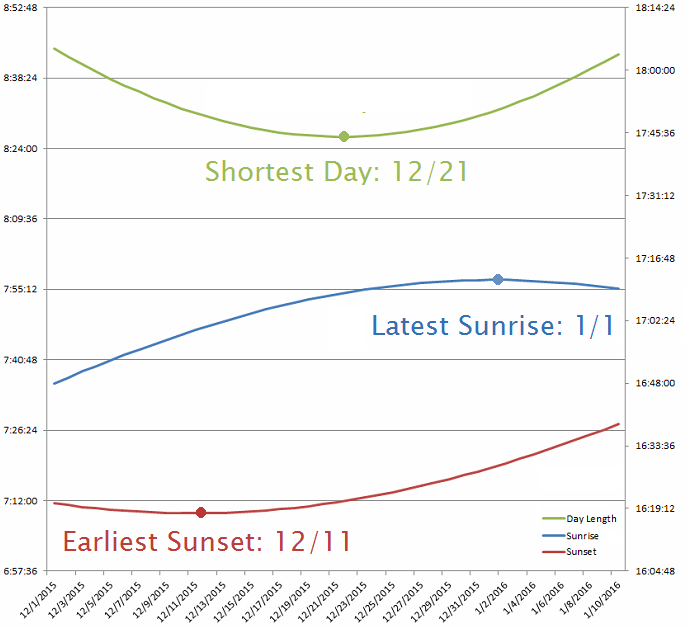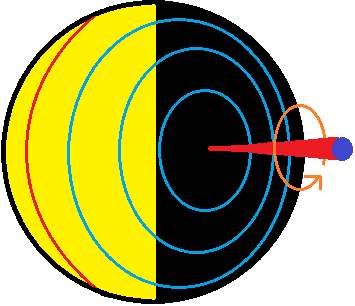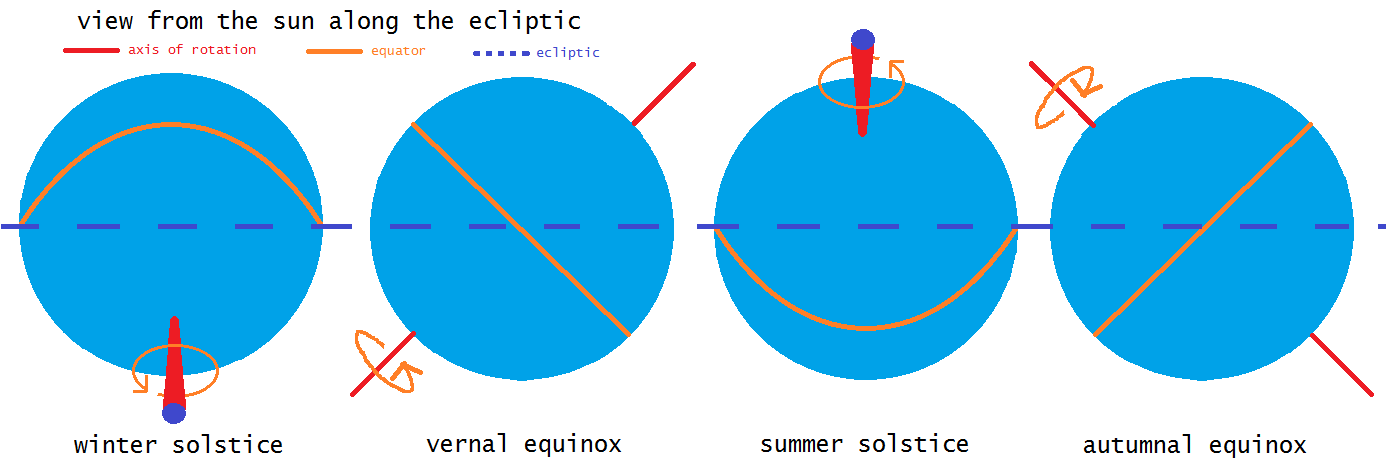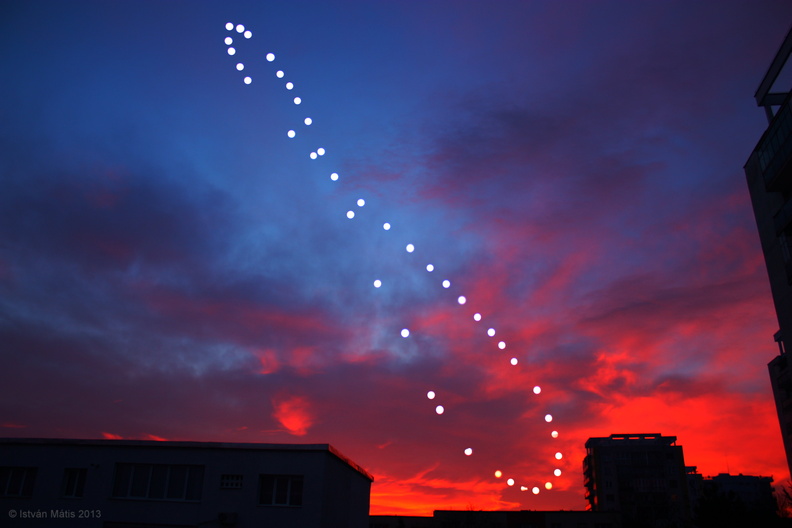Most people are familiar with the idea that the length of the day varies with the seasons. Especially for those in the more northern latitudes, it’s an obvious feature of the winter that the sun rises later and sets earlier than in the summer. Throughout history and across northern cultures, the winter solstice is celebrated to herald the imminent return of light; after the shortest day, things can only get brighter!
One would expect that following the winter solstice — the shortest day — the sun will begin rising earlier and setting later in the day in order to make it longer. That is, we’d expect the sun to be highest at noon and have sunrise and sunset start moving away symmetrically on either side as the days get longer. What surprises many, and left me at a partial loss to explain when asked about it, is the fact that this is not so. In fact, the sun continues to rise later in the morning for many days following the winter solstice — and begins setting later days before it! The reason is truly celestial.
Observed Trends
First, let’s establish the facts of the situation. In 2015, the winter solstice fell on the 21st of December. For anyone standing at the equator, that day was just about as long as any other. But for anyone in the northern hemisphere, it was the shortest day of the year. Let’s consider the sunrise and sunset times for Seattle, a particularly good example city to consider since it sits roughly halfway between the equator and the north pole.
The above graph spans a six week period around the solstice. The blue and red curves are the sunrise and sunset times, respectively, and the green curve is the length of the day. From this it’s clear that the relative extremes in sunrise and sunset times actually sit about ten days away on either side of the solstice.
This effect isn’t limited to Seattle, but it is a function of latitude. The graph below shows the days of latest sunrise and earliest sunset along Seattle’s meridian (122°W) sampled at whole degree latitudes between the equator and the north pole.
So not only do these extremes straddle the solstice at every latitude, but they converge on it toward the north pole and rapidly widen the gulf toward the equator. At the equator, the earliest sunset of 2015 was on November 2nd, and the latest sunrise won’t happen until February 11th 2016! [1]
Axial Tilt: Day Length and Seasons
So what’s going on? Let’s recall the dynamics: even as it orbits the sun, the earth is spinning along a central axis that runs right though both poles. That axis is tilted about 23.5 degrees from perpendicular to the plane in which the earth orbits called the ecliptic. Like a gyroscope, the axis points in the same direction relative to the ecliptic all the time regardless of the earth’s orbital or rotational motion [2]. So this means that throughout the year, the north pole goes from pointing toward the sun to pointing away and back again.
The solstices are the days of the longest or shortest length, or equivalently the days when the sun is highest or lowest in the sky at local noon. But now we can also think of the solstices as the instantaneous moment in the orbit of the earth when its axis is maximally tilted toward or away from the sun. Here’s another view of the winter solstice from directly above the ecliptic with the sun shining from the left.
Each circle is a latitude, and a point on each takes a single day to rotate. On the winter solstice, any latitude on above the article circle — at 66.5 degrees north — stays in shadow all day. The farther south, the sooner the sun swings into view and the greater part of the day’s rotation is spent illuminated. From this angle, even some of the southern hemisphere is visible (but only an illuminated portion). The situation is exactly reversed at the summer solstice, with the portion of the southern hemisphere we could see from here in darkness; and in between those extremes is a gradual, sinusoidal shift as the earth orbits around. This totally explains the seasonal difference in the amount of daylight we experience.
Concepts of Day
Thinking about the orbital motion of the earth affecting daylight leads naturally to the fact that there are two concepts of “day” that are important to consider here. Most people probably consider a day to be the time it takes for the earth to rotate around one complete time. That’s what’s known as a sidereal or stellar day, easily measured by following the relative position of distant stars in the sky. The siderial day is just a consequence of the fact that the earth is spinning, and it’s actually just under 24 hours. The 24-hour day we know and love is the solar, tropical, or synodic day: it’s the time it takes for the sun to move from local noon through nighttime and back again. The difference between the two is entirely due to the orbital motion of the earth.
In the above diagram, the solar day is longer than the siderial day by exactly the time it takes for the earth to move from B to C and return the sun to its highest point above the horizon for the fixed point on the surface [3]. So given that our clocks measure solar days — convenient for keeping clock times relatively in sync with regard to the sun throughout the year — we’d expect sunrise and sunset changes to mirror each other about equally.
Kepler’s Laws and Orbital Speed
Note in the diagram above that the angle of the drift between the siderial and tropical markers is given with a variable. That’s because it actually does vary throughout the year! The orbit of the earth is not a perfect circle, but rather a nearly-circular ellipse. Johannes Kepler was a seventeenth century astronomer now best remembered for his laws of planetary motion. It is Kepler’s First Law (really an observational generalization better explained through gravity [4]) that every planet’s orbit is an ellipse with the sun at one focus. It is Kepler’s Second Law (likewise another observational generalization better explained through gravity) that for a given period of time, planets sweep out an equal area, not an equal distance, in their orbits. Taken together, this means that earth’s orbital speed must vary throughout the year.
Since the speed of the earth’s orbital motion fluctuates annually, the length of the solar day fluctuates along with it as it takes more or less time for the sun to return to apparent noon. Now that sundials are mostly out and intercontinental travel is in, the 24-hour day we use is actually the mean solar day. But when the earth is moving faster, the actual solar day is shorter than the mean solar day that our clocks measure, and vice versa. In fact, the actual solar day varies in length from between 20 seconds less to 30 seconds more than its average value.
It so happens that the earth is closest to the sun, and hence moving the fastest, in the northern hemisphere’s winter [5]. That closest approach and fastest orbital speed is called the perihelion, and it happens on January 3rd [6]. For weeks on either side of that date, the apparent solar day is shorter than the mean, moving apparent noon earlier and earlier in the day as measured by 24-hour clock time. This slides the sunrise earlier along with it.
Axial Tilt: Effect on Apparent Noon
This isn’t the only factor playing with apparent solar time though; the axial tilt also plays a role. As discussed earlier, the solstices are the times when the axis is perfectly tilted toward or away from the sun, and the equinoxes are when the axial tilt is parallel to the earth’s instantaneous orbital motion. The earth swings through these extremes twice in one year, and this affects the apparent position of the sun from day to day at a variable rate.
At the solstices, the angle between the equator and the ecliptic is greatest, so the day-to-day apparent motion of the sun is mostly parallel to the horizon. But at the equinoxes, the equator and the ecliptic are parallel and the apparent motion of the sun follows a slanted path through the sky; hence its vector of movement is less horizontal, less affecting the time to reach apparent noon. After passing through the equinox, the apparent drift of the sun moves back toward a purely horizontal motion at the following solstice, where the orientation of the axis has totally reversed from the preceding solstice. This has the effect of a side-to-side motion of the sun, completing two periods annually.
The Equation of Time
These two factors — the elliptical nature of earth’s orbit and the tilt of its axis — combine to cause the apparent solar day to vary in length throughout the year. Their periodic effects are just functions of the degree that earth’s orbit departs from perfectly circular, or its eccentricity, and the degree that its axis is tilted from the ecliptic, or its obliquity. Together they form what is called the Equation of Time — so named for the medieval sense of reconciling two varying quantities — which measures how many minutes apparent solar noon has drifted from mean solar time.
Above is the Equation of Time as well as both of its components. Note that the eccentricity curve (in orange) has a period of one year with zeroes at perihelion in early January and aphelion in early July, while the obliquity curve (in green) has a period of half a year with zeroes at the solstices and equinoxes. The y-axis of this graph is the number of minutes by which local noon has drifted ahead or behind of mean solar noon. Put another way, when the Equation of Time (the composition of both curves, in blue) is above the x-axis, a sundial will appear to be fast when compared with a clock measuring mean solar time. [7]
How does this help us understand the shifting of sunrise time around the winter solstice? Around that time, the value of the Equation of Time is positive while its slope is very negative. This means that before the solstice, the sun is rising and setting early against clock time, even while the orbit of the Earth and the Equation of Time are both working to push the sunrise later into the day. The Equation of Time has a zero on the 25th of December; that’s the point where the apparent solar day overtakes the mean solar day and becomes longer, so that the sun to rises and sets later as compared with clock time. In general terms then, the Equation of Time is tugging the sunrise and sunset earlier before Christmas and tugging them both later afterward. And since the slope of the curve around that zero is steep, the daily affect of this tugging is quite pronounced all around the solstice.
Sunrise and Sunset Extreme Shifts Explained
Putting it all together then, we have two effects controlling the characteristics of the apparent day: the latitude of the observer, which affects the declination of the sun and hence the times at which it moves into and out of view at the horizon; and the Equation of Time which tugs apparent noon back and forth with respect to clock time. Revisiting the observation that started this essay, we noted that sunrise and sunset time extremes hugged the winter solstice, the shortest day, but did so much more tightly at high latitude. The effect of increasing latitude is to change day length, day-to-day, by shifting the apparent declination of the sun; but the amount of day length change at the solstice, day-to-day, is at a minimum, increasing in magnitude moving away from the solstice and toward the equinox.
In that window of little daily change around the solstice, the Equation of Time has a dominating effect in sliding the sunrise and sunset times at all latitudes. Near the poles though, the orbit of the earth changes the declination of the sun very rapidly day-to-day, quickly pushing sunrise earlier and sunset later even after accounting for the Equation of Time. The closer to the equator, the less rapidly the changing declination of the sun affects day length changes day-over-day, so the Equation of Time dominates sunrise and sunset time changes for longer periods away from the solstice. At the equator, where latitude plays no role in day length change at all, the Equation of Time is the only controlling effect. And recall that the equator’s sunrise and sunset extremes were November 2nd and February 11th? Those are the dates of the maximum and minimum values of the Equation of Time!
Analemma and Long-Term Cycles
Since the Equation of Time governs the delta between apparent and mean time (and hence the apparent position of the sun), it also forms the east-west component of the analemma, the figure-eight the sun does annually in the sky when viewed at the same time from the same position throughout the year. The north-south component of the drift comes from the axial tilt’s effect on the declination of the sun as viewed from Earth. The fact that it’s a figure eight is because the effect of eccentricity and obliquity vary throughout the year, each taking turns in magnifying and softening the drift, causing the Equation of Time to dip above and below the x-axis four times annually. The southern lobe is larger in the northern hemisphere since the perihelion, when the earth is moving faster, falls close to the winter solstice, when the sun is lower in the sky. The opposite is true in the the southern hemisphere, where the analemma has a larger lobe higher in the sky.
Other planets have equations of time too, and their different shapes result in different analemmas. Mercury’s axial tilt is less than one degree, so its analemma is just a single point. Mars has an axial tilt similar to Earth’s with a somewhat more eccentric orbit, but since its perihelion aligns closer to its equinox, its analemma is shaped like a tear drop. Uranus has an extreme axial tilt of 88 degrees as well as nontrivial eccentricity, so it gets a figure-eight analemma too; but its equation of time can cause the apparent solar time to swing hours away from its mean solar time at various points in its orbit! [8]
As if all this weren’t complicated enough, it should be noted that the Equation of Time on Earth drifts year-over-year very slightly. Due to tidal forces from the sun and moon, the orientation of the axis of the earth drifts through a full circle once about every 26,000 years. Since the orientation of the axis totally controls solstices and equinoxes, this effect is called the precession of the equinoxes, and it is translating the equation’s obliquity component very slightly each year. Due to a number of effects including general relativity and the relative positions of massive planets in the solar system across time, the perihelion of the earth also precesses about the sun in a roughly 112,000 year cycle. This translates the eccentricity component of the Equation of Time, and in fact both these precessions combine to make the perihelion revolve once relative to the equinoxes once in only 21,000 years. In fact, the magnitude of the eccentricity of Earth’s orbit also varies on a 100,000 year cycle, and that affects the amplitude of the equation’s eccentricity component. All these cycles, collectively known as Milankovitch Cycles, have an effect on the analemma, moving it from a bottom-heavy figure-eight to a teardrop to a top-heavy figure-eight and back again over thousands of years.
Conclusion and Endnotes
So that explains the sun setting later before and rising earlier after the solstice: the Equation of Time literally changes the length of day and the clock time of apparent noon. The effect is more pronounced at low latitudes but is felt everywhere, and the effect will shift along with the precessing equinoxes through the ages [9]. Together with the tilt of Earth’s axis, this causes the very position of the sun to trace a great figure eight in the sky every year called the analemma. No wonder the ancients worshiped the sun — celestial mechanics is nuts!
— — — — — — — — — — — — — — — — — — — — — — — — — — — — — — — — — — — — — — — —
[1] Seattle daytime data and sunrise/sunset extremes along the 122°W meridian were obtained, in part, through the use of the PyEphem python library.
[2] The constancy of the orientation of the axis is oversimplification due to the precession of the equinoxes. In fact, the orientation of the axis rotates through a 26,000 year cycle, taking about 70 years to move one degree. Year-over-year, this effect can be ignored.
[3] The solar day is longer than the sideral day because the earth both spins and orbits anticlockwise; if the orientation of spin and orbit disagreed, then the solar day would be slightly shorter than the siderial day.
[4] The underlying principle is that any two orbiting objects are actually spinning about their center of mass, called their barycenter, which may or may not lie within either. For example, the Pluto-Charon system has its barycenter in open space. The constant motion of the barycenter, as well as other stray gravitational effects, all distort earth’s orbit from a perfect circle at a constant distance from the sun.
[5] Remember that even though a frequent naive explanation for seasonal temperature differences is being closer to or farther from the sun, the axial tilt is solely responsible for them; the difference in distance to the sun is very slight, varying less than 2% from average throughout the year. Technically this means that northern hemisphere seasons are very slightly milder than those in the southern hemisphere, but without the axial tilt the effect would be barely noticeable.
[6] The date of perihelion is currently January 3rd, but this is only the case for the time being. Due to the precession of the perihelion, the perihelion orbits the sun once every 112,000 years or so. When combined with the precession of the equinoxes, the day on which Earth’s perihelion falls advances about every 60 years. Year-over-year, this effect can be ignored.
[7] For a more mathematical treatment of the Equation of Time and its affect on local noon, go here.
[8] For more on the analemma, read this scienceblog page, which also recapitulates several of the topics discussed here.
[9] For a helpful if pedantically narrated video explaining a lot of these concepts, go here.









